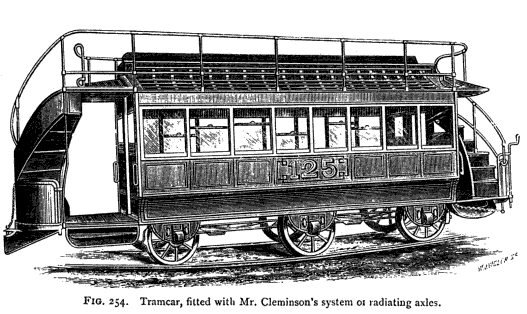This website has been archived from TrainWeb.org/i3 to TrainWeb.US/i3.
![[home]](/i3/graphics/i3.gif) |
Radial-Axle Passenger Tramcar, by Mr. James Cleminsonby D. Kinnear Clark |
contents |
The following is transcribed from a reprint of Tramways - Their Construction and Working, by D. Kinnear Clark, with the kind permission of the publisher.
 Radial-Axle Passenger Tramcar, by Mr. James
Cleminson
Radial-Axle Passenger Tramcar, by Mr. James
Cleminson
MR. CLEMINSON'S system of three axles, forming a self-adjusting or "flexible" wheel-base, complies with the conditions of the problem of a free passage along curves in a satisfactory manner. The axles, with their axle boxes, springs, and guards, are mounted in independent frames, one to each axle, separate from the main underframe of the carriage. The end frames are fitted with central picots, on which they swivel freely, whilst the middle frame is so arranged that it can slide transversely. The three frames are connected together by articulated radiating gear, so that they act sympathetically, in such a manner that when the carriage or the car, leaving a straight portion of the way, passes on to a curve, the ended axles are deflected horizontally, forming angles with the central axle, and taking up radial positions coincident with the radii of the curve. By means of such self-acting adjustment, the car rolls freely round the curve. When, conversely, the car passes from the curve to the straight line, the axles resume their parallelism, and the car rolls on naturally in a straight line. The automatice action arises from the translation of the middle axle and frame transversely on a curve : the relative lateral movement of the middle frame in communicated to the near sides of the end frames, causing them to swivel on their pivots, and to turn the end axles into appropriate radial positions.
Mr. Cleminson's radial-axle tramcar, Fig. 254, has been at work on the Dublin and other tramways. The wheels are placed widely apart under the body of the car, and the pitching movement incidental to the working of tramcars constructed with the ordinary contracted wheel-base, is extinguished. This car seats 18 passengers inside, and 20 outside ; total number, 38. The weight of the car is 45 cwt., equivalent to 1.18 cwt. per passenger.
| i3@rrmail.com | 2002.07.21 |















